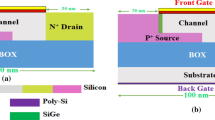Abstract
This work presents an investigation of the performance assessment of E-mode Mg-doped In0.2Ga0.8N/Al0.23Ga0.77N/GaN/Al0.05Ga0.95N on AIN substrate use for high-power applications. The effect of the back-barrier on AIN substrate to boost the high-temperature performance of the device was analyzed using a hybrid technique of finite element simulations in the physics-based Synopsys TCAD 2018 simulation tool. The back-barrier on the AIN substrate improves the performance of the device through the improvement of electron mobility with increasing temperature. The proposed device’s maximum transconductance gm of 47 mS/mm at room temperature was significantly reduced to 16.1 mS/mm at a high temperature of 673 K by the AIN substrate and back-barrier interfacial layers. Boosted current flow of Vds = +15 V from +4 V was observed. A record off-state thermal breakdown voltage of 1200 V at a temperature of 673 K was achieved with the device. An appreciable high ratio of ION/IOFF for both devices at high temperatures was observed. There was no significant difference between up and down sweeps of the threshold voltage due to ohmic resistance. FE simulation indicated both AIN substrate and back-barrier interfacial layers had very small gate-drain turn-on voltages due to the limited threshold voltage (Vth). Consistent variation of GaN channel temperature from 329 K to 550 K for power dissipation from 1 to 10 W/mm with AIN substrate and back-barrier interfacial layers was observed.












Similar content being viewed by others
References
X. Huang, Q. Li, Z. Liu, and F.C. Lee, Analytical Loss Model of High Voltage GaN HEMT in Cascode Configuration. IEEE Trans. Power Electron. 29, 2208–2219 (2014). https://doi.org/10.1109/TPEL.2013.2267804.
Joel T. Asubar, Zenji Yatabe, and Tamotsu Hashizume, Reduced Thermal Resistance in AlGaN/GaN Multi-Mesa-Channel High Electron Mobility Transistors. Appl. Phys. Lett. 105, 053510 (2014). https://doi.org/10.1063/1.4892538.
Ali M. Darwish, Andrew Bayba, and H.A. Hung, Channel Temperature Analysis of GaN HEMTs with Nonlinear Thermal Conductivity. IEEE Trans. Electron Devices. 62, 840–846 (2015). https://doi.org/10.1109/TED.2015.2396035.
Z. Wang and J. Honea, IEEE Workshop on Wide Bandgap Power Devices and Applications (WiPDA); 81–87 (2014)
A. Nigam, T.N. Bhat, S. Rajamanan, S. Tripathy, and M. Kumar, Effect of Self-Heating on Electrical Characteristics of AlGaN/GaN HEMT on Si (111) Substrate. AIP Adv. 7, 085015 (2017). https://doi.org/10.1063/1.4990868.
H. Amano, Y. Baines, E. Beam, and Matteo Borga, The 2018 GaN Power Electronics Roadmap. J. Phys. D Appl. Phys. 51, 163001 (2018). https://doi.org/10.1088/1361-6463/aaaf9d.
A. Chvála, J. Marek, P. Príbytný, A. Šatka, M. Donoval, and D. Donoval, Effective 3-D Device Electrothermal Simulation Analysis of Influence of Metallization Geometry on Multifinger Power HEMTs Properties. IEEE Tran. Elec. Dev. 1, 64 (2017). https://doi.org/10.1109/TED.2016.2629024.
S. de Filippis, V. Košel, D. Dibra, S. Decker, H. Köck, and A. Irace, ANSYS Based 3D Electro-Thermal Simulations for the Evaluation of Power MOSFETs Robustness. Microelectron. Rel. 51, 1954–1958 (2011). https://doi.org/10.1016/j.microrel.2011.06.047.
V. Košel, S. de Filippis, L. Chen, S. Decker, and A. Irace, FEM Simulation Approach to Investigate Electro-Thermal Behavior of Power Transistors in 3-D. Microelectron. Rel. 53, 356–362 (2013). https://doi.org/10.1016/j.microrel.2012.09.002.
D. Chvála, A. Donoval, M. Šatka, J. Molnár, and P.. Príbytn.ý Marek, Advanced Methodology for Fast 3-D TCAD Device/Circuit Electro-Thermal Simulation and Analysis of Power HEMTs. IEEE Trans. Elec. Dev. 62, 828–834 (2015). https://doi.org/10.1109/TED.2015.2395251.
TCAD Sentaurus. Sdevice User Guide, Synopsys ver.G-2018.
Franck Nallet, Luca Silvestri, Tommaso Cilento (2014) TCAD simulation methodology for electrothermal analysis of discrete devices including package. In: Proceedings 26th Int. Symp. Pow Semicon Devi & IC's Waikoloa, Hawaii https://doi.org/10.1109/ISPSD.2014.6856044
Takayuki Sugiyama, Hiroshi Amano, Daisuke Iida, Motoaki Iwaya, Satoshi Kamiyama, and Isamu Akasaki, High-Temperature Operation of Normally Off-Mode AlGaN/GaN Heterostructure Field-Effect Transistors with p-GaN Gate. Japanese J. Appl. Phys. 50, 01AD03 (2011).
N. Yafune, S. Hashimoto, K. Akita, Y. Yamamoto, H. Tokuda, and M. Kuzuhara, AlN/AlGaN HEMTs on AlN Substrate for Stable High Temperature Operation. Electron. Lett. 50, 211–212 (2014). https://doi.org/10.1049/el.2013.2846.
Yusuf U. Tarauni, D. John Thiruvadigal, Bijo Joseph, and A. Mohanbabu, Optimization of Enhancement Mode P-type Mg-Doped In0.2Ga0.8 N Cap Gate for Low-Loss High Power Efficient Boost Converter Circuits. Mater. Sci. Semicond. Process. 103, 104624 (2019).
Albert G. Bacaz, Brianna A. Klein, Andrew A. Allerman, and Andrew M. Armstrong, Al0.85Ga0.15N/Al0.70Ga0.30N High Electron Mobility Transistors with Schottky Gates and Large On/Off Current Ratio over Temperature. ECS J Solid State Sci. Technol. (2017). https://doi.org/10.1149/2.0231712jss.
R. Sommet, G. Mouginot, R. Quéré, Z. Ouarch, and M. Camiade, Thermal Modeling and Measurements of AlGaN/GaN HEMTs Including Thermal Boundary Resistance. Microelectr. J. 43, 611–617 (2012).
Guowang Li, Tom Zimmerman, and Yu. Cao, Threshold Voltage Control in Al0.72Ga0.28N/AlN/GaN HEMTs by Work-Function Engineering. IEEE Electron Device Let 31, 954–956 (2010). https://doi.org/10.1109/LED.2010.2052912.
T. Nanjo, A. Imai, Y. Suzuki, Y. Abe, T. Oishi, M. Suita, and Y. Tokuda, AlGaN Channel HEMT with Extremely High Breakdown Voltage. IEEE Trans Electron Devices 60, 1046–1053 (2013).
T. Nanjo, M. Takeuchi, M. Suita, T. Oishi, Y. Abe, Y. Tokuda, and Y. Aoyagi, Remarkable Breakdown Voltage Enhancement in AlGaN Channel High Electron Mobility Transistors. Appl. Phys. Lett. 92, 263502 (2008). https://doi.org/10.1063/1.2949087.
M. Hatano, N. Yafune, H. Tokuda, Y. Yamamoto, S. Hashimoto, K. Akita, and M. Kuzuhara, Superior DC and RF Performance of AlGaN-Channel HEMT at High Temperatures. IEICE Trans. Electr. 95, 1332–1336 (2012).
Lu. Xing, Huaxing Jiang, Chao Liu, Xinbo Zou, and Kei May Lau, Off-State Current Leakage Reduction in AlGaN/GaN High Electron Mobility Transistor by Combining Surface Treatment and Post-Gate Annealing. Semi. Cond. Sci. Technol. 31, 055019 (2016).
S.K. Powell, N. Goldsman, J.M. McGarrity, J. Bernstein, C.J. Scozzie, and A. Lelis, Physics-Based Numerical Modeling and Characterization of 6H-Silicon-Carbide Metal–Oxide–Semiconductor Field-Effect Transistors. J. Appl. Phys. 92, 4053–4061 (2002).
G. Bastard, Wave mechanics applied to semiconductor heterostructures (New York: John Wiley & Sons, 1990).
S. Schoche, P. Kuhne, T. Hofmann, M. Schubert, D. Nilsson, A. Kakanakova-Georgieva, E. Janzen, and V. Darakchieva, Electron Effective Mass in Al0.72Ga0.28N Alloys Determined by Mid-Infrared Optical Hall Effect. Appl. Phys. Lett. 103, 212107 (2013). https://doi.org/10.1063/1.4833195.
F.F. Fang, and W.E. Howard, Negative Field-Effect Mobility on (100) Si Surfaces. Phys. Rev. Lett. 16, 797 (1966).
J.H. Davies, The physics of low-dimensional semiconductors (Cambridge: Cambridge University Press, 1998).
S.B. Lisesivdin, A. Yildiz, N. Balkan, M. Kasap, S. Ozcelik, and E. Ozbay, Scattering Analysis of Two-Dimensional Electrons in AlGaN/GaN with Bulk Related Parameters Extracted by Simple Parallel Conduction Extraction Method. J. Appl. Phys. 108, 013712 (2010).
B.L. Gelmont, M. Shur, and M. Stroscio, Polar Optical-Phonon Scattering in Threeand Two-Dimensional Electron Gases. J. Appl. Phys. 77, 657 (1995).
M.E. Coltrin, and R.J. Kaplar, Transport and Breakdown Analysis for Improved Figure-of-Merit for AlGaN Power Devices. J. Appl. Phys. 121, 055706 (2017). https://doi.org/10.1063/1.4975346.
M.E. Coltrin, A.G. Baca, and R.J. Kaplar, Analysis of 2D Transport and Performance Characteristics for Lateral Power Devices Based on AlGaN Alloys. ECS J. Solid State Sci. Technol. 6, S3114–S3118 (2017). https://doi.org/10.1149/2.0241711jss.
D. Maier, M. Alomari, N. Grandjean, J.F. Carlin, M.A. Diforte-Poisson, C. Dua, and E. Kohn, Testing the Temperature Limits of GaN-Based HEMT Devices. IEEE Trans. Device and Mater Reliability 10, 427–436 (2010).
B.J. Baliga, Modern power devices (New York: Wiley-Interscience, 1987).
F. Bertoluzza, N. Delmonte, and R. Menozzi, Three-Dimensional Finite Element Thermal Simulation of GaN-based HEMTs. Microelectron. Reliability. 49, 468–473 (2009). https://doi.org/10.1016/j.microrel.2009.02.009.
E.A. Douglas, F. Ren, and S.J. Pearton, Finite-Element Simulations of the Effect of Device Design on Channel Temperature for AlGaN/GaN High Electron Mobility Transistors. J. Vacuum Sci. Technol. B 29, 020603 (2011).
M. Fish, P. McCluskey, and A. Bar-Cohen, Modeling of Thermal Microspreading Resistance in Via Arrays. J. Electron. Packag. 138, 010909 (2016). https://doi.org/10.1115/1.4032348.
H. Huang, Y.C. Liang, G.S. Samudra, T.F. Chang, and C.F. Huang, Effects of Gate Field Plates on the Surface State Related Current Collapse in AlGaN/GaN HEMTs. IEEE Trans. Power Electr. 29, 2164–2173 (2013).
Jo Das, Herman Oprins, Hangfeng, Andrei Sarua and Gustaaf Borghs (2006) A Temperature Analysis of High-Power ALGAN/GAN HEMTS. In: Dans Proceedings of 12th International Workshop on Thermal investigations of ICs-Therminic, Nice France. arXiv:0709.1868v1
Patrick H. Carey, Fan Ren, Albert G. Baca, and Stephen J. Pearton, Operation Up to 500C of Al0.85Ga0.15N/Al0.7Ga0.3N High Electron Mobility Transistors. J. Electron Device Soc. 9, 444–452 (2019). https://doi.org/10.1109/JEDS.2019.2907306.
Y.U. Tarauni, D.J. Thiruvadigal, and H.B. Joseph, Characterization and Optimization of MIS-HEMTs Device of High~ k Dielectric Material on Quaternary Barrier of Al0. 42ln0. 03Ga0. 55N/UID-AIN/GaN/GaN Heterostructure for High Power Switching Application. Appl. Surf. Sci. 488, 427–433 (2019).
Acknowledgment
The authors gratefully acknowledge the support from the Centre for Material Science and Nanodevices, Department of Physics & Nanotechnology, Faculty of Engineering and Technology, SRM Institute of Science & Technology, Chennai, India, and the Department of Physics, Kano University of Science & Technology, Wudil, for providing all facilities to carry out this research work.
Author information
Authors and Affiliations
Corresponding author
Ethics declarations
Conflict of Interest
On behalf of all authors, the corresponding author states that there is no conflict of interest.
Additional information
Publisher's Note
Springer Nature remains neutral with regard to jurisdictional claims in published maps and institutional affiliations.
Rights and permissions
About this article
Cite this article
Tarauni, Y.U., Thiruvadigal, D.J., Hotoro, M. et al. Influence Analysis of Back-Barrier and AIN Substrate on the High-Temperature Performance of an E-Mode Mg-Doped In0.2Ga0.8N Capped Gate High Electron Mobility Transistor for High-Power Switching Applications: A Simulation Study. J. Electron. Mater. 51, 5219–5229 (2022). https://doi.org/10.1007/s11664-022-09767-5
Received:
Accepted:
Published:
Issue Date:
DOI: https://doi.org/10.1007/s11664-022-09767-5




